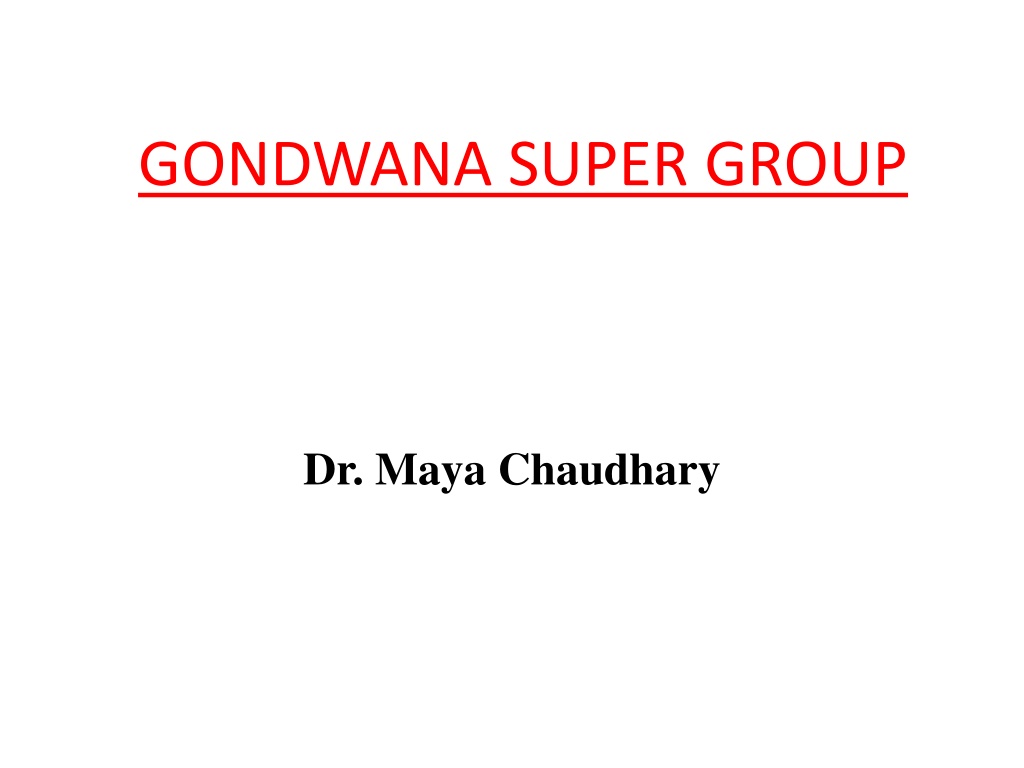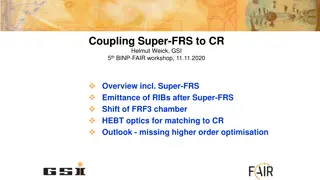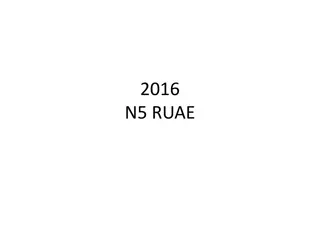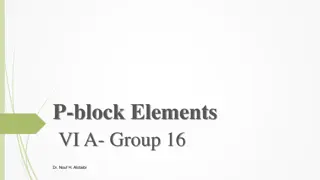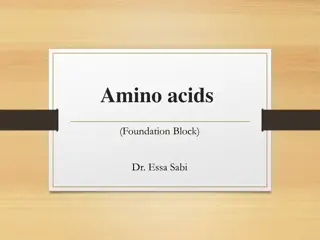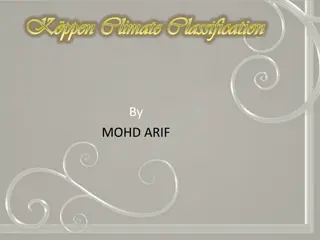Understanding the Gondwana Super Group and Its Classification
The Gondwana Super Group, named after the Gond Kingdom, consists of sedimentary rocks deposited from the Carboniferous to Jurassic periods. These rocks provide insights into changing climatic conditions over millions of years. Classification of the Gondwana rocks is based on paleontological and lithological criteria, with debates over two-fold and three-fold classifications. The formation of Gondwana land connected present-day southern continents.
Download Presentation

Please find below an Image/Link to download the presentation.
The content on the website is provided AS IS for your information and personal use only. It may not be sold, licensed, or shared on other websites without obtaining consent from the author. Download presentation by click this link. If you encounter any issues during the download, it is possible that the publisher has removed the file from their server.
E N D
Presentation Transcript
GONDWANA SUPER GROUP Dr. Maya Chaudhary
Introduction.. Subsequent to the deposition and uplift of the Vindhyan rocks during the Pre- cambrian era, the peninsula witnessed no further deposition of sediments for a pretty long time. During the Up. carboniferous period, however there commenced a new cycle of sedimentation in interconnected inland basins of fluviatile and lacustrine origin. This new phase of deposition of sediments continued up to the end of the Jurassic period. These inland sediments of Up carboniferous to Jurassic age occupying a vast tract in the peninsula and together constitute the Gondwana Group or system (named after the Gond Kingdom of M.P., where they were first, studied by H.B Medlicott in 1872). The Southern continents of the present day namely Australia, Antarctica, South America and India were during the Gondwana period united together to form one continuous stretch of land, known as Gondwana land.
1. The deposition of Gondwana sediments commenced under glacial climatic conditions. 2. Then there prevailed a warm and humid climate during the rest of the Up. carboniferous and the whole of the Permian. 3. Throughout triassic , there prevailed a dry and arid climatic condition. 4. During Jurassic again the country appears to have witnessed a more or less warm and humid climate. 5. Each individual cycle commenced with the deposition of coarse sand. The Gondwana rocks were subjected to tectonic disturbances during the Mid triassic, Jurassic and Post-Eocene periods leading to the development of a number of faults in them. They were also traversed by doleritic, lamprophyre dykes and sills which in the Damodar valley area are said to be genetically related to the Rajmahal- traps.
Classification. On the basis of the palaeontological, strati-graphical and lithological criteria, two types of classifications have been proposed for the rocks of this sequence : (a) The two-fold classification have been proposed by C. S. Fox, M. S. Krishnan etc., in which they have divided the Gondwana rocks on the basis of floral characteristics into Lower Gondwana rocks characterised by Glossopteris flora and the Upper- Gondwana sediments marked by the advent of the Ptilophyllum flora. (b) The three-fold classification has been proposed by Feist- mantel, Vredenburg, D.N. Wadia etc. on the basis of prevailing climatic conditions and faunal characteristics of the Gondwana era. The three subdivisions are as follows: In spite of several views for and against either of the classification, the modern trend is more in favour of the two-fold classification.
Classification of Gondwana Rocks: Following is the outline of three-fold classification which is based primarily on stratigraphical evidence, each division being assigned to a particular system in Standard Geological Scale. https://www.geographynotes.com/wp-content/uploads/2018/02/clip_image002_thumb-14.jpg
In the two-fold division, based primarily on fossil evidence, the dividing line lies between the Panchet Series and the Mahadeva Series as shown in Table.
Important facts (i) Talchir stage is made up of greenish shales known as Needle shales , due to the characteristic weathering which they exhibit. (ii) Damuda series contains coal seams of Permian age. (iii) The Barakar stage is well developed in the Jharia coal field. (iv) The Barren measures is devoid of fossils and contain nodules of clay-ironstone.
(v) Raniganj stage contains thick horizons of coal seams. (vi) Panchet series was deposited in an arid climatic condition, and is devoid of coal seams. (vii)Himgiri beds in Mahanadi valley: Pali beds of South-Rewa. Kamthi beds of Satpura in Madhya Pradesh belong to Damuda series. (viii) Overlying the Damuda series of South Rewa is the Pasa- sora stage. (ix) Bap beds and Pokran beds in Rajasthan contain boalders of Vindhyan limestone and are assigned to the age of Talchir Ullite. (x) The Tiki beds of Rewa and Denwa and Bogra stages. off Satpura are equivalent to the Maleri stage.
(xi) Rajmahal stage is principally made up of lava, flows. (xii) Dubrajpur Sandstone belongs to the Mahadeva series in the Raniganj hills. (xiii) The upper part of the Kota stage is known as Chikiala. (xiv) The Kota stage is well developed in Godavari valley. (xv) Chaugan and Jabalpur stage belongs to Jabalpur series. (xvi) The Barakar and Raniganj stages of the Damuda series constitute the most important coal-bearing horizons of the Gondwana succession. (xvii) The rocks of the Gondwana system constitute a total thickness of 6,000 to 7,000 metres. (xviii) The glaciated boulder bed called the Blaini Conglomerates of Simla Hills lying at the base is equivalent to the Talchirs. (xix) The Tanaki Boulder Bed (Glacial) of Hazara is believed to be contemporaneous with that of the Talchir.
Origin of Gondwana Rocks: It is widely accepted that Gondwana Rocks are of fluviatile origin, that is, these have been deposited by streams and rivers in the so called Gondwana basin. The basin itself is thought to have been of the nature of a gradually sinking broad trough where deposition of the sediments was accompanied by the subsidence of the basin (under the load) so that huge accumulations were possible in due course of time. This mode of origin is confirmed by their fossil content as well as their geotectonic (structural) relations with other rocks in the area of occurrence. The Gondwana Group of rocks form the most important stratigraphically, geologically and economically groups of India.
Stratigraphically Stratigraphically, they form evidence of beginning of the end of a southern continent including present India, Australia, South America, South Africa, Madagascar and Antarctica that existed as a unit after Vindhyan times and has been named as Gondwanaland. Numerous streams, rivers, lakes and other shallow-water-bodies that existed during that period received sediments and continued to get depressed right through Triassic and Jurassic times. It was sometime during Cretaceous period that this great continent cracked and the resulting parts drifted through subsequent times to the present locations. During the period it remained together as a land mass, it accumulated huge volume of sediments along with remains of great variety of life that existed during that period and migrated very freely. Peninsular India bears great evidence of these accumulations that are spread over vast areas of Bengal, Bihar, Orissa, Madhya Pradesh and Maharashtra. The rocks form a composite group, in stratigraphical sense, rather than a single system, in as much as it contains rocks belonging to more than one true system, that is, of Triassic system, Jurassic system and Cretaceous system.
Geologically Geologically, the Gondwana group presents us with best example of subsidence along major trough faults amidst the older rocks. In fact, deposition and preservation of great accumulation of sediments could have been possible due to such sinking basins. The total thickness of Gondwana sediments is estimated to be around 6000 m or even more.
Economically Economically, the Gondwana rocks are the biggest source of COAL deposits in India. Besides this black gold, Gondwana have yielded good quality building stones, clays and iron ores of importance.
Distribution of Gondwana Rocks: The Gondwana group has been named after the ancient Gond kingdom of Madhya Pradesh, the name having been used first by H.B. Medlicott in 1872. The Gondwana rocks are traced along three large tracts in Peninsular and Central India: (i) In Bengal along the valley of Damodar. (ii) In Maharashtra along the Godavari River. (iii) In Madhya Pradesh, parallel to Mahanadi Valley. Isolated tracts of Gondwana rocks are also found in extra Peninsula, especially in Himalayan foot-hills in Nepal, Bhuttan, Assam and in the middle Himalayas of Kashmir.
Lithology of Gondwana Rocks: 1. Lower Gondwanas: This division is made up primarily of shales and sandstones with occasional layers of grits and very wide occurrence of coal in two of the three stages. The Talchir Series is the lowest member and has a tillite or boulder bed, at its own base, which is of great stratigraphical significance. It is 15 to 60 m thick and is considered to be of fluvioglacial origin indicating extension of glacial climate to those areas of Peninsula at the time of its deposition. The boulder bed is followed upwards by greenish, fragmentary type shales and greenish coloured sandstones in that sequence.
The Damuda System, so called because of their considerable thickness, and named after Damodar River, is made up of: (i) Sandstones and grits, generally white in appearance and about 750 m in thickness, designated as the Barker stage. This stage contains numerous coal seams and is considered Chief Coal Bearing Stage in Lower Gondwana. (ii) Finer varieties of sandstones, about 600 m thick, but without any coal Barren Series. seams, hence called (iii) Fine-grained sandstones, shales and Coal Seams, designated as Raniganj Series, from the type area where their thickness approaches about 1000 m.
2. Middle Gondwana: Rocks of this subdivision are also made up primarily of Sandstones and Shales which show some variation in texture, structure and colour in different series at different places. The Panchet Series is made up of sandstones of buff, brown and green appearance associated with shales in the upper part. They are occasionally felspathic. The Mahadeva Series is about 1500 m thick, and is made up of typically red coloured sandstones having layers of red coloured clays at the base and top of the series. The red colour is clearly due to haematitic (iron oxide) content. The series is distinguished into a number of stages such as Pachmari stage, Maler stage, Denwa Bagre stage and Kota stage. The last named stage contains a few layers of limestone. The Kota stage is also known for having yielded dinosaurian fossil bones.
3. Upper Gondwana: This group indicates a petrological variation in that its lower series, the Rajmahal series, is made up mostly of basaltic lava flows which contain inter-trappean clays and shales rich in Carbonaceous matter and important fossils. In many aspects, the Rajmahal Traps resemble Deccan Traps. The Jabalpur series is lithologically a thick formation of massive sandstones and white clays in the type area. The Umia series is developed in Kutch and is made of sandstones in the lower region (Umia stage) and calcareous shales with some typical marine fossils in the middle, Ukra stage. The upper, Bhuj stage has yielded remains of conifer plants.
Life of Gondwana Rocks: Gondwanas have yielded a rich assemblage of animal and plant fossils that establish close relationship of Peninsular India with Australia, South America, South Africa and Madagascar etc. believed to have been a single continental unit during that span of time. The list of Gondwana fossils is exhaustive; only a very few species are mentioned below:
Lower Gondwana: Plant Fossils: Glossopteris indica; Gangamopteris cyclopteroides; Vertebraia indica; Schizoneura sp.; Noegerathiopsis hislopi; Buriadia sewardi; Callipteridium sp., Schizoneure gondwanasis, Barakaria dichotoma; Dictyopteridum sporiferum; Phyllotheca indica; Taeniopteris feddeni. Middle Gondwana: a. Labyrinthodonts: Gonioglyptus longirostris, Glyptognathus fragilis, Pachygonia incurvata. b. Reptiles: Dicynodon orientalis, Epicampodon indicus, Rhyncosaurian sp, Phytosaurian sp, Enythrosuchoid sp. c. Crustacea: Estheria mangliensis. d. Plants: Ptilophyllum acutifolium, Elatocladus jabelpurensis, Retinosporites indica.
Upper Gondwana: Plant Fossils: Ptilophyllum acutifolum, Nitsonnia princeps, Williamsonia indica, W. blanfordi, Taeniopteris vittata, Eletocladus conferata, Plegiophyllum peregrium, Elatocledus Brachyphyllum expansum, macropteris; Lycopodites gracilis, Cladophlebis whitbyensis. jabalpurensis, Araucarites
Economic Importance of Gondwana Rocks: 1. Coal: Gondwana rocks, particularly the Lower Gondwanas are considered the storehouse of coal for India. These rocks contain extensive reserves spread in numerous seams distributed vertically and laterally at many places in Bihar, Jharkhand, Bengal, Orissa and Madhya Pradesh. Coking and steam coals are abundant in Barkar Stage. Bituminous coals of non-coking type, however, form the bulk of Gondwana coals. There are different estimates for the coal reserves of Gondwana; according to one estimate, these reserves available only in thick seams (thickness more than 1.2 m) are of the order of 35000 million tonnes. 2. Iron Ore: Gondwana rocks have been the source of carbonate iron ore (Siderite) in Raniganj coalfields, Auranga and Hutar coalfields. Their reserves are estimated at about 2000 million tonnes. 3. Clays: Refractory clays also called fire-clays have been extracted from many places in Barkar stage coal seams. Similarly clays useful for variety of other purposes have also been found associated with coal seams in Gondwana and support a well-developed ceramic industry. 4. Building Stones: Most Gondwana formations are made up of sandstones and clays only. Of these, there are some good quality sandstones found at Pachmari, Raniganj and Barker that are quarried for use as a dressed stone in many places.
